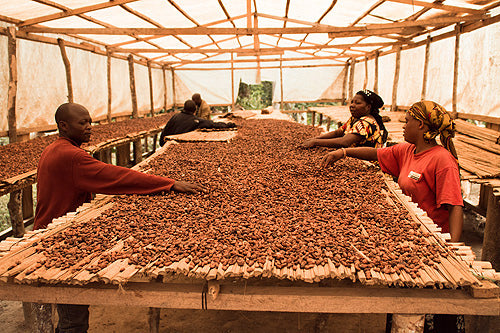The Intoxicating Science Behind Chocolate

Since its first documented use around 1100 BC in a bitter drink enjoyed by the Mayans and Aztecs, the seed from the Theobroma cacao tree has been enjoyed by people everywhere. In the 19th century, an emulsification process created by John Cadbury turned this seed into the delectable treat now known as chocolate. Today, chocolate is one of the most popular foods in the world - one that people just can't get enough of. This article will take a look at the intoxicating science behind how chocolate is made and how this craveable treat affects the body.
Processing the Cacao Beans
Cacao beans naturally have a bitter flavor, so they must be processed to develop the flavor we all love. After harvesting, cacao pods are split open and have the pulp and seeds scrapped out, which are left to ferment for two to eight days.
The longer the fermentation stage lasts, the better the quality of chocolate. Then the beans are spread thinly to dry completely in sunlight.Chocolate manufacturers roast the dried cacao beans to bring out the rich chocolate flavors. After roasting, the shells of the beans are removed by a machine called a winnower. The remainders, also called nibs, are then ground to create chocolate liquor - a thick, rich paste that contains no alcohol, despite its name. The chocolate liquor is put into a press, which separates it into cacao butter and a powdery cacao presscake.
Making Natural Chocolate
At this point, the preparation of chocolate varies depending on the exact recipe being used. To make natural chocolate, cacao butter, sugar, vanilla, and milk are added to chocolate liquor and sent through a series of rollers, to smooth the chocolate's texture.Then it is sent to a conching machine, which kneads the chocolate for a few hours or even days. Variables such as the speed, time, and temperature during this stage affect the final taste and texture of the chocolate.After conching is complete, the chocolate is tempered to create a smooth, shiny surface on the final product. The liquid is then poured into molds and allowed to harden into delicious chocolate bars and candies.
Artificial Chocolate
In an effort to use fewer cacao beans and cacao butter, artificial chocolate was created. Although artificial chocolate is cheaper to manufacture, the results are of a lower quality than natural chocolate. Shavings of the cacao presscake are used in place of chocolate liquor in artificial chocolate Vegetable fats are used to substitute part of cacao butter in the recipe. The percentage of vegetable fats that can be used and still be called "chocolate" is defined differently in different countries and is still a subject of debate.
Where Chocolate Comes From
Native to Central and South America, the cacao tree can only grow within 20 degrees latitude of the equator. While chocolate is now grown all throughout the tropics, Africa currently produces 70% of the world's cacao beans.Many people argue over where the best finished chocolate comes from. While there certainly is room for personal preference between the different chocolate recipes, some of the most commonly named favorites are Swiss and Belgian chocolates.
Chocolate's Chemical Reaction with the Body
Chocolate may be delicious, but that isn't the only reason that so many people find it absolutely irresistible. Chocolate may affect hormone levels and actually make you feel better when you eat it. Scientists attribute this effect to the alkaloids found in chocolate, the most common of which are theobromine, phenethylamine, and caffeine. When these alkaloids enter the body, they affect serotonin in the brain, which contributes to overall feelings of happiness.
Chocolate may also have other physiological effects on the body, such as lowering blood pressure, improving the function of the circulatory system, and reducing cholesterol. These effects are most pronounced in dark chocolate, thanks to antioxidants. While these antioxidants are also present in milk chocolate, the additional milk interferes with their absorption. Despite these benefits, it is still best to consume chocolate in moderation due to its high caloric content.
Chocolate as an Aphrodisiac?
Because chocolate can make you feel happier, many people believe it to be an aphrodisiac. Even the Aztecs and Mayans considered their chocolate drink to be a "love potion". Even though chocolate can positively affect your feelings, this effect is too small to make chocolate a true aphrodisiac. Despite this, chocolate is considered a romantic food or gift.
Perhaps it is romantic because it is a sweet "forbidden" treat that you shouldn't have, but indulge in from time to time.So the next time you eat a piece of chocolate, don't just pop it straight into your mouth. Think about the intoxicating science and story behind chocolate - a delectable treat that has been enjoyed for over 3,000 years, that you too are about to enjoy.
